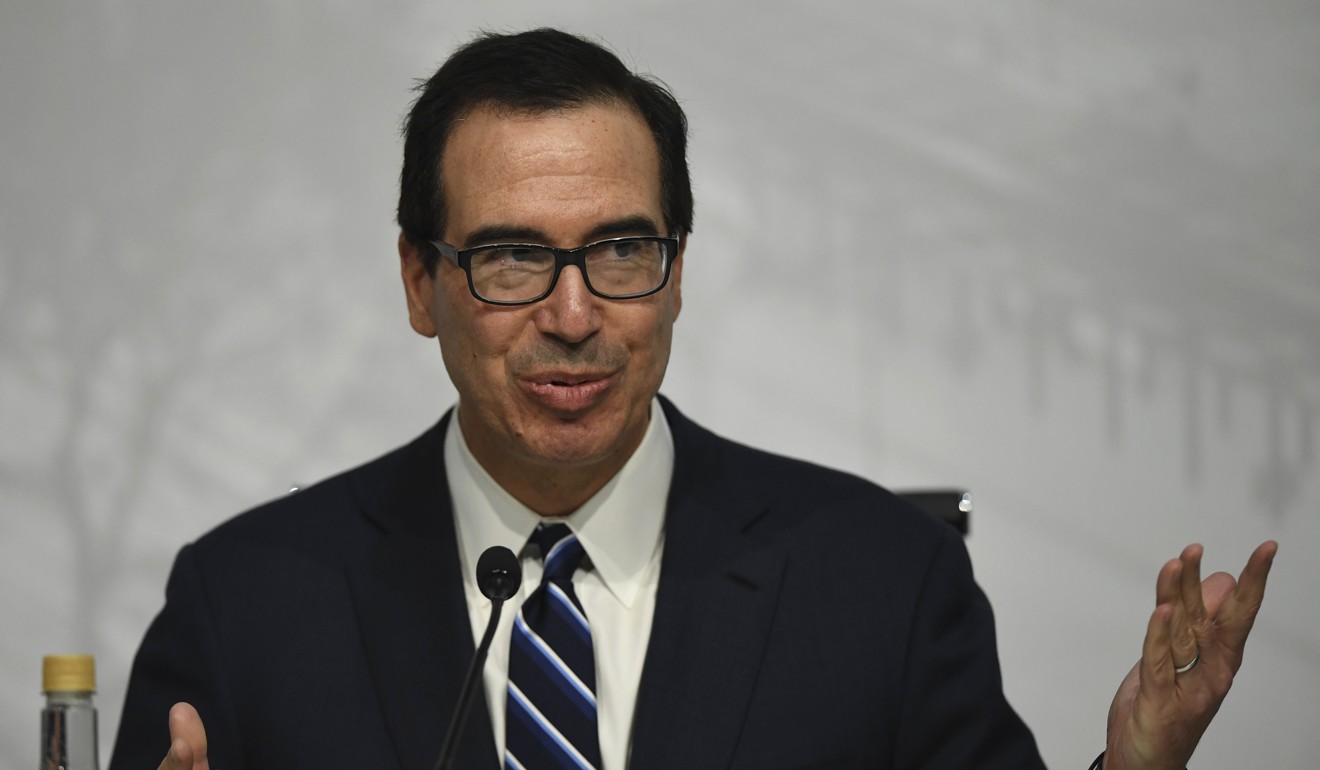
IMF chief Lagarde dismisses idea Beijing is manipulating the yuan as Washington turns up the heat
Christine Lagarde says the yuan’s decline of 10.5 per cent against the greenback since February ‘has a lot to do with the strength of the dollar’
International Monetary Fund chief Christine Lagarde has dismissed the idea that China is manipulating its currency to gain a competitive advantage, giving verbal support to Beijing as Washington reiterates its concerns about the yuan’s exchange rate.
Lagarde’s remarks on Thursday came just a day after US Treasury Secretary Steven Mnuchin warned China not to engage in a competitive devaluation of its currency.
Mnuchin was quoted by the Financial Times on Wednesday as saying that the Treasury monitored currency issues “very carefully” and that the Chinese yuan, also known as renminbi, had fallen “significantly” during the year. He added that he wanted to discuss the currency with Beijing as part of trade talks.

“If you compare the position of the renminbi relative to the US dollar, it has a lot to do with the strength of the dollar,” the IMF’s managing director said at a press conference during the IMF and World Bank Group annual meetings in Bali, Indonesia.
“If you compare [other currencies] to the renminbi, there is a bit of depreciation, but certainly not that much.”
Lagarde admitted that China was allowing greater fluctuations in the yuan’s exchange rate than previously, something the IMF is in favour of.
“We are seeing more and more countries, including China, let their currencies fluctuate,” she said. “And that certainly has been the case for the last three years for China.
“We have supported the move of China to allow more flexibility [of the yuan exchange rate], and we hope that the recommendations we have given to China regarding letting the currency fluctuate will continue to be implemented.”
The yuan has fallen 10.5 per cent against the US dollar since its recent high in early February. It was trading at 6.93 to the dollar in the offshore market on Thursday morning, after the People’s Bank of China, the country’s central bank, set the midpoint of the currency’s daily trading range at 6.9098.
But the yuan remains stronger than this year’s low point of 6.9586, which it hit in mid-August. If it approaches that level again, the market will be watching for signs that the Chinese central bank may intervene to defend the “psychologically important” level of 7 to the dollar, as it has done in the past.

The debate over the cause of the yuan’s weakness comes a few days before the US Treasury is due to release its semi-annual exchange rate report. There is growing speculation that it could formally name China as a currency manipulator for the first time.
A senior US Treasury official, who briefed reporters on Monday, also expressed concern about the depreciation of the Chinese currency, as well as recent moves by Beijing to strengthen government control over the exchange rate.
“We continue to closely monitor developments in the yuan; we remain concerned about the recent depreciation of the yuan,” said the official, who spoke on condition of anonymity.
“More broadly, we’re concerned about China’s turn away from more market-oriented policies and continued reliance on non-market mechanisms that impact the macroeconomic and trade environment.”
In August, with the yuan sliding rapidly because of rising trade tensions, China’s central bank reintroduced the use of a “countercyclical factor” in the calculation of the yuan’s daily trading range. The move gave the People’s Bank of China more control over the currency’s value and allowed it to halt its slide.
The official said questions about the yuan would be addressed in the Foreign Exchange Report, which he said was likely to be released next week. The official gave no clue as to what the report might conclude about Chinese foreign exchange policies.
US President Donald Trump has frequently accused China of interfering with the exchange rate, though until now the Treasury Department has never determined that China meets the criteria to be labelled a currency manipulator. However, as Washington’ attitude toward China hardens, there is speculation that stance could change when the report comes out.
The report is governed by two separate trade laws: the Omnibus Trade and Competitiveness Act of 1988 (1988 Act), and the Trade Facilitation and Trade Enforcement Act of 2015 (2015 Act).
Whether China is formally labelled a currency manipulator by the Treasury will depend on the extent of the standards and criteria of the two laws.
Under the 2015 Act, China only meets one of the three criteria for currency manipulation, namely that a country runs a significant bilateral trade surplus with the US of at least US$20 billion. It does not meet the second condition of running a current-account surplus of at least 3 per cent of its gross domestic product. Nor does it meet the third criterion of engaging in persistent, one-sided intervention in the foreign-exchange market, which the US Treasury defines as being when “net purchases of foreign currency are conducted repeatedly and total at least 2 per cent of an economy’s GDP over a 12-month period”.
China, however, could still be labelled a currency manipulator if the US Treasury decides to rely more heavily on the older 1988 Act, which allows for a more subjective assessment of whether a currency is being manipulated to gain unfair competitive advantage in trade.
The Treasury’s currency report will be released just a few weeks after the US currency manipulation guidelines were included in the new United States-Mexico-Canada Agreement. Even though exchange rates are not an issue between the three countries, the move was interpreted as the first step in a US effort to include such language in all new trade deals, such as those between negotiated now with the European Union and Japan.

